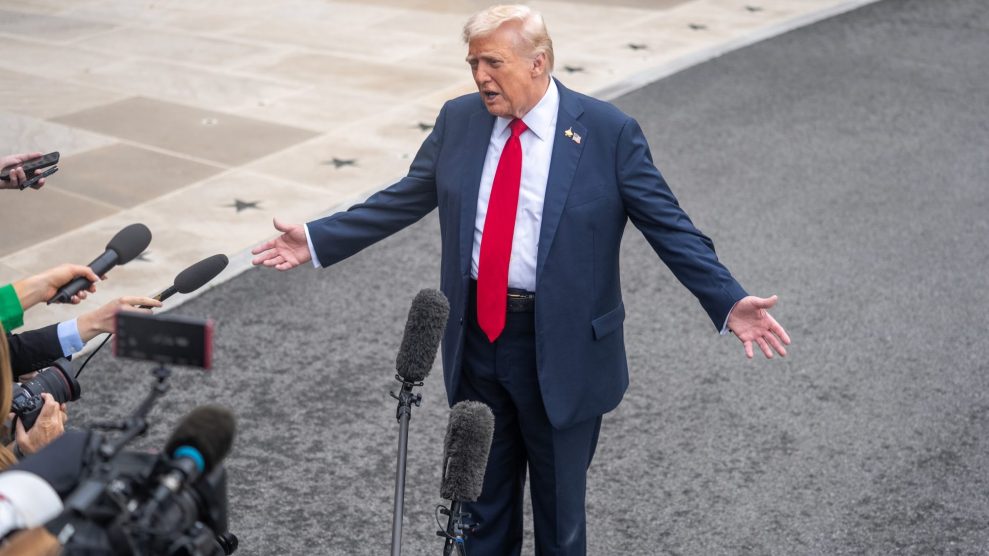At the risk of dating myself, back in 1988, when I was close to graduating from college, the average THC level in pot was 3.5 percent. And today? Well today the government says it’s 8.5 percent, which is up from 7 percent in 2003. And if I scored some weed in Oregon, it’s possible that I’d be buying pot that has a THC level of 33.12 percent. Clearly, as Dr. Nora Volkow, director of the National Institute on Drug Abuse (NIDA), scolds us, “we are not talking about the drug of the 1960s and 1970s— this is Pot 2.0.“
Ah, the 2.0 meme. We at MoJo are guilty of of exploiting it ourselves. In this case, what do these numbers mean? To this Reason says:
As The Drug War Chronicle’s Scott Morgan notes, this increase is a far cry from drug czar John Walters’ 2002 claim that “the potency of available marijuana has not merely ‘doubled,’ but increased as much as 30 times”—a ratio that could not possibly hold true unless you were comparing the most potent marijuana money can buy to nonpsychoactive ditchweed.
Clearly, Nick Gillespe and his crew know their chronic. Invite us to some Reason parties! Extra points if we can party with Jack Shafer.
So different pot has different potencies. This has always been true, or I have read. But consider that the figures that NIDA quotes rely on research from the University of Mississippi’s Marijuana Potency Project. As Gary Greenberg reported in MoJo back in 2005, NIDA grows pot at Ole Miss—a partnership that forms the only legal producer of marijuana in the U.S. (and an irony I’ll leave to fellow fans of Terry Southern to mull over). Ole Miss bases this particular batch of research on “59,369 samples of cannabis, 1,225 hashish samples, and 443 hash oil samples” that have been confiscated since 1975.
(Wait just a minute, what about the aforementioned pot from the 60s and [half of] the 70s?)
But while 62K-odd samples of weed sounds like a lot and all, what of NIDA/Ole Miss’ ability to assess potency? As Greenberg points out (in a piece on the affect a sprayable form of medical marijuana known as Sativex might have on both sides of the drug debate that is much more serious than this blog post), the anti-drug policies of the government have filtered down to Ole Miss’ research, to the point where:
NIDA’s brown, stems-and-seeds-laden, low-potency pot—what’s known on the streets as “schwag”—cannot stack up against the dense green, aromatic, and powerful sinsemilla favored by most medical marijuana patients (and grown by Sativex producer GW). Doblin asked the University of Mississippi to grow the good stuff for him, but they refused, so he approached a botanist at the University of Massachusetts, who applied to the DEA to grow research-grade pot in a 200-square-foot room in the basement of a building in Amherst. This started a whole new kind of collegiate rivalry, the Rebels squaring off against the Minutemen over the quality of their pot. In a letter to the DEA, Mississippi’s botanist—after pointing out that no one had ever officially complained about the “adequacy” of their product—trumpeted recently acquired “custom-manufactured deseeding equipment” and a new stock of seeds that had allowed Ole Miss to amass more than 50,000 joints’ worth of a “special batch” of high-potency, smooth-smoking weed.Three and a half years after UMass kicked off the battle—and only after a judge ordered the feds to make their decision—the Rebels prevailed, its monopoly preserved when the DEA denied UMass the license necessary to grow pot legally.
Ya gots to love the fight for government grants. In any case, the feds have taken their potency data and used it to craft a film called “The Purple Brain” (purple being the 2.0 version of Maui wowie), which NORML is calling Reefer Madness 2.0.
As in so many things these days, one wishes for something approximating independent analysis. I don’t trust the government’s research on drugs; its hyperbole and scare tactics on pot in particular seemed design to defend status quos (border and prison policies) that worsen, not solve, larger societal problems at hand. Nor do I trust NORML et al, even, and perhaps especially, when, having gotten nowhere on legalization per se, they reframe the issue as a balm for the sick and dying. Allowing medical marijuana is a no-brainer in my book, but I just think it’s a little unseemly when perfectly healthy pot-positive types hide behind AIDS and cancer patients.
The problem is that as long as the government forbids most independent marijuana studies—by limiting the ability to get the stuff legally—we’re likely to remain buffeted by agendas, not guided by science.
But meanwhile, don’t those confiscated samples of pot providing some kind of trend line seem fishy on its face? Any statisticians out there?

















